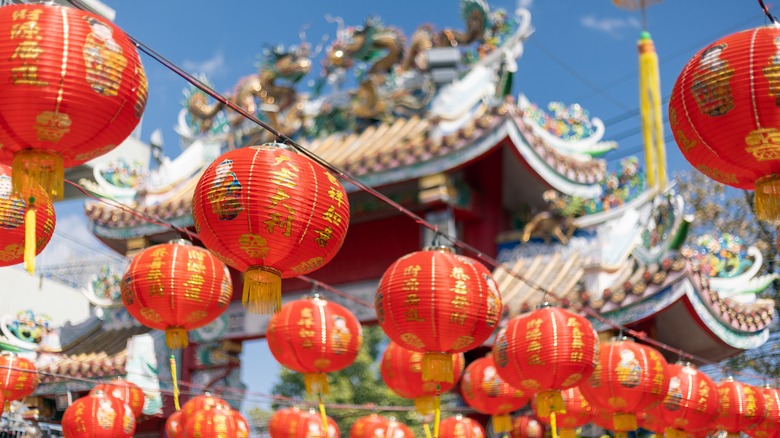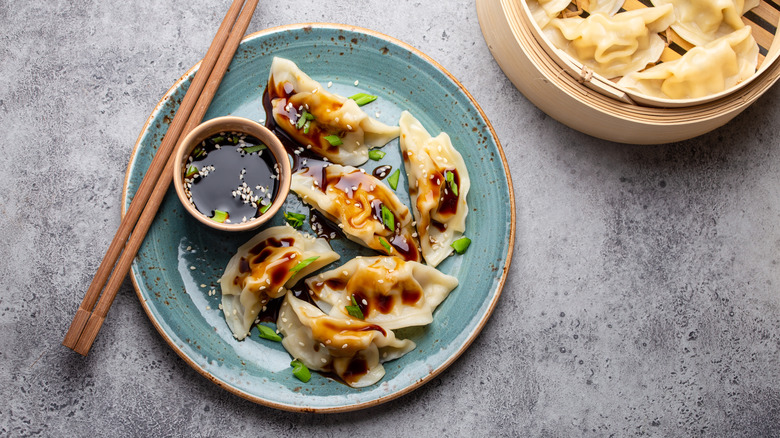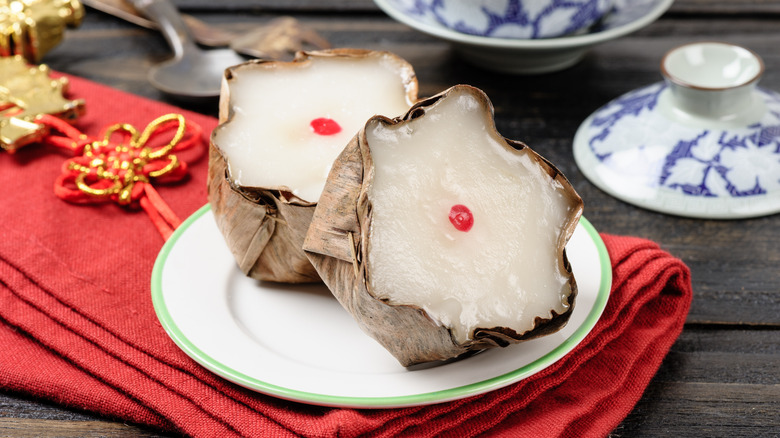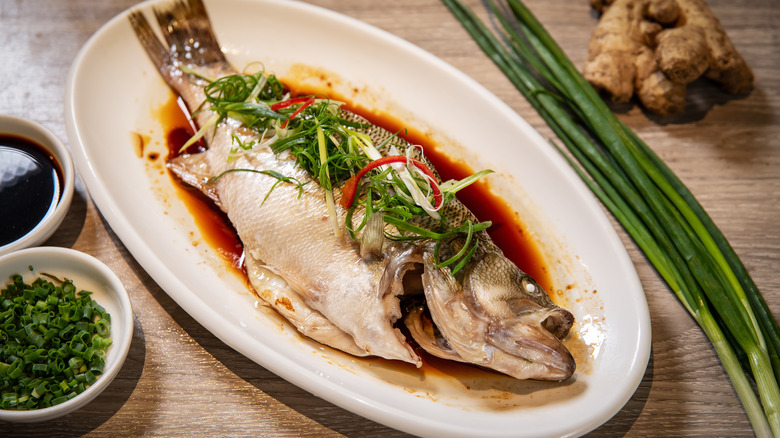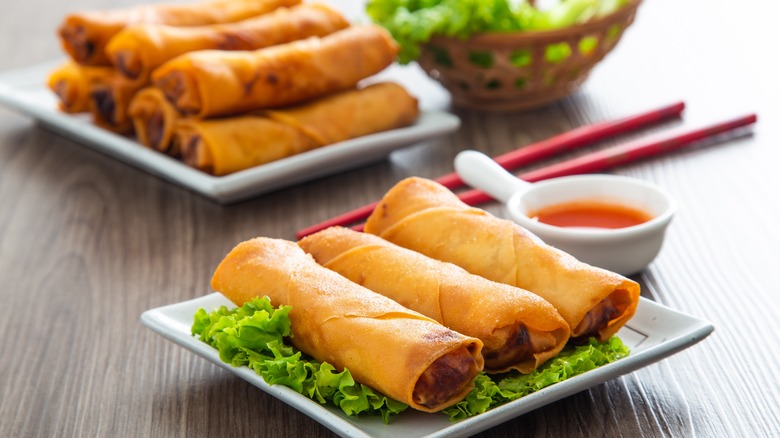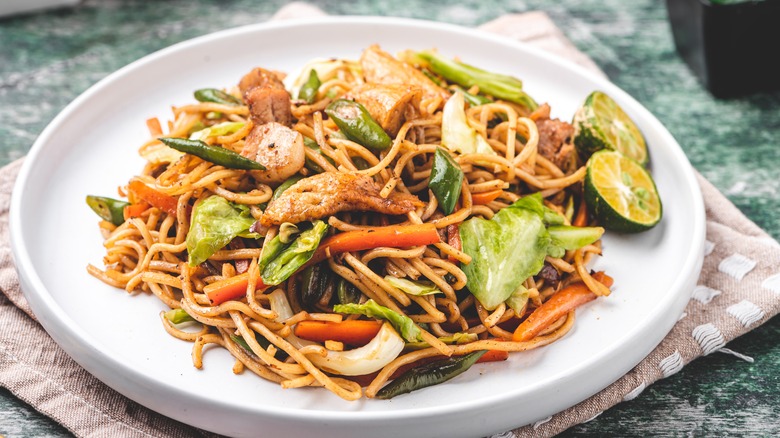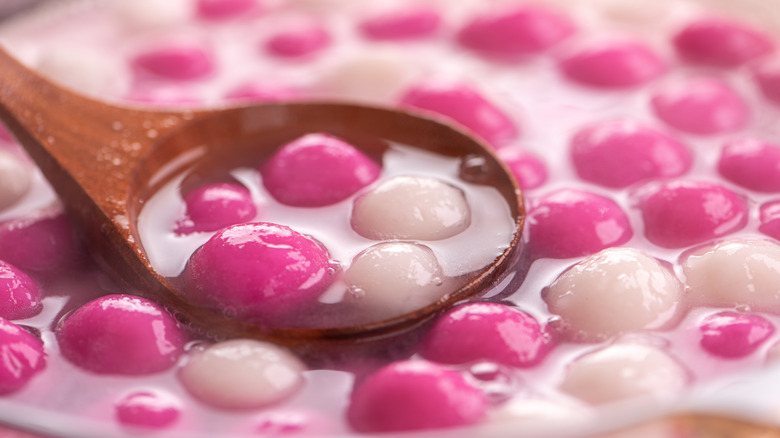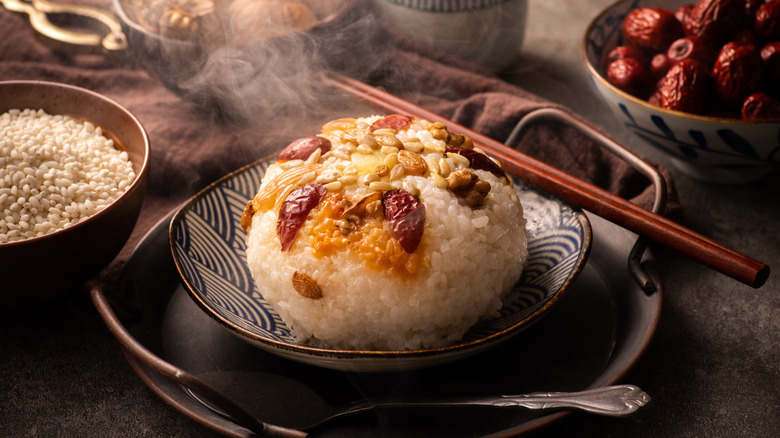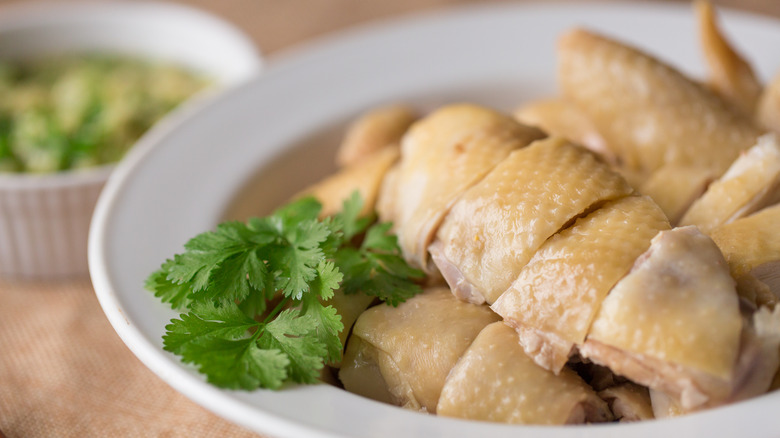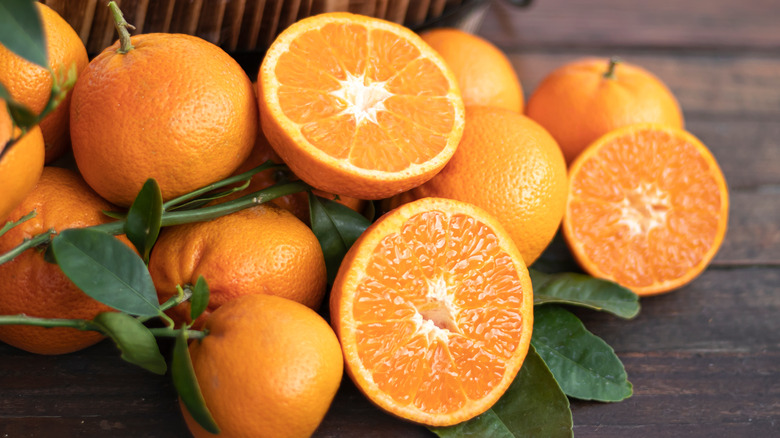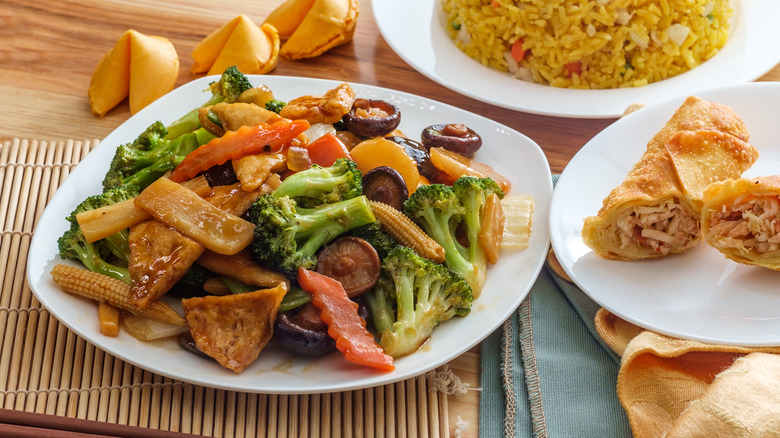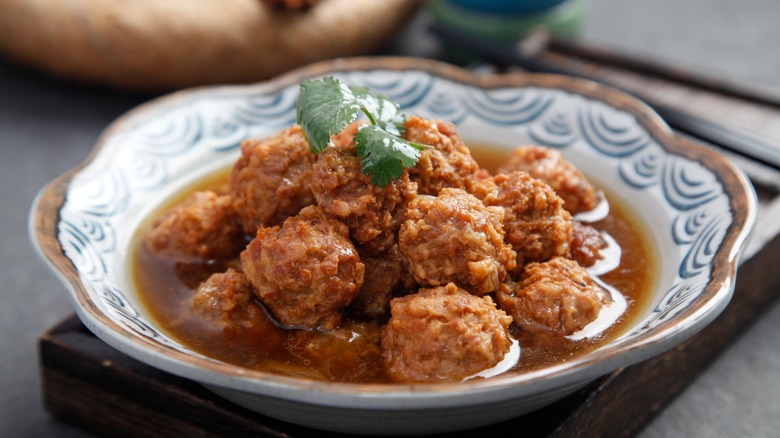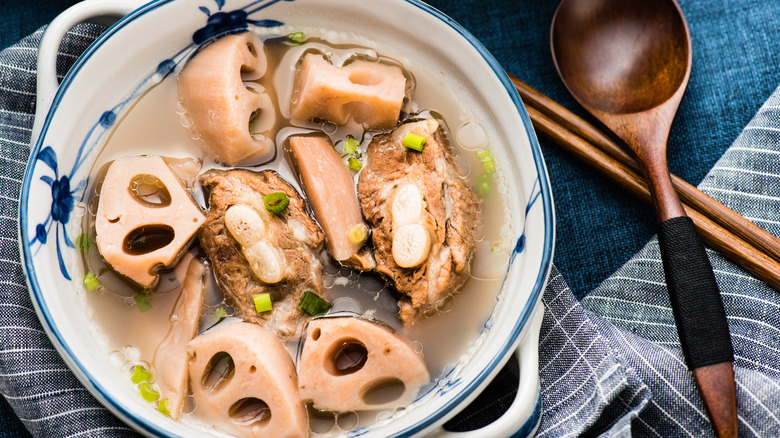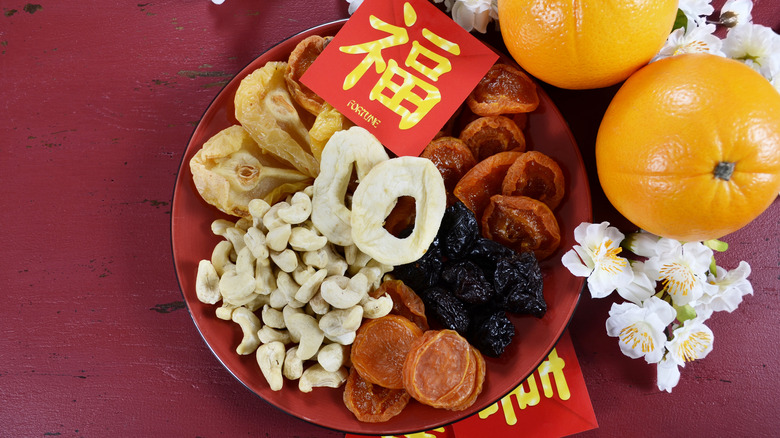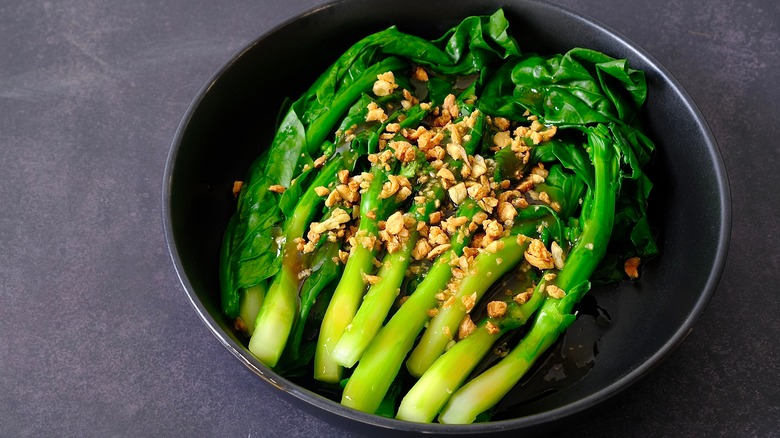14 Traditional Foods To Enjoy During Chinese New Year
Across the globe, many cultures have devised ways to usher in the new year, usually with much pomp, joy, and enthusiasm. In China, the festivities last for 15 days, a week of which is a public holiday. The date of the Chinese New Year varies every year; because it follows the lunar calendar, it occurs on the second new moon after the Winter solstice. As such, the festival also welcomes the beginning of spring, which is why you may hear the Chinese New Year referred to as the Spring Festival or the Lunar Festival.
As China's most significant celebration, the festivities and food are unmatched. The first banquet is a reunion dinner on New Year's Eve; it's an opportunity for all the family to gather together and enjoy foods that symbolize luck, prosperity, and harmony. There are many new year's food superstitions worldwide, but have you heard of noodles that determine the length of your life? Wordplay that suggests eating special snacks might bring you gold? We like the sound of that! Let's delve into the traditional foods you can enjoy during the Chinese New Year.
Jiǎozi, Chinese dumplings
Chinese New Year celebrations aren't just about enjoying a meal together — they're also about spending precious time with your family preparing the meal together. There's no better way to bond, laugh, and learn as a family than to make dumplings.
Although there are many different types of Chinese dumplings, jiǎozi (light and soft steamed dumplings) are guaranteed to be present at every dinner table in the Northern Chinese provinces. Per Asian Inspirations, the tradition of eating dumplings to celebrate the New Year dates back to the Ming dynasty, between the 12th and 15th centuries. Everyone ate dumplings within the last hour of the old year and the first hour of the new year. Within one of the dumplings hid a silver coin; the person to find this coin would have blessings of luck for the rest of the year. In the contemporary age, you're likely to find coins, peanuts, Chinese red dates, and sweet candy hidden within the dumplings. Each is associated with a particular blessing: coins with wealth; peanuts with long, healthy life; Chinese red dates with fertility; and sweet candy with happiness, (via Sun-Bird Seasonings).
Nián gāo, Chinese New Year cake
A cake is typically at the forefront of any celebration, and this is no exception. In Northern China, people make nián gāo by steaming glutinous rice flour, sugar, and water together in a small woven bowl lined with banana leaves. Often, revelers will place a small, circular piece of red paper on top of the Chinese New Year cake. Red has long been associated with power, happiness, celebration, fertility, and even repelling evil. So, from paper lanterns to sweets, you'll see the color everywhere during Chinese New Year.
Due to the relatively small number of syllables in modern Chinese languages, homophones — characters that sound the same but have different meanings — are common. Nián gāo means sticky cake and "higher year," (via the Journal of Pragmatics), which symbolizes children's growth, higher income, and better times to come, explains Inquirer.net. The source continues by telling the story of how nián gāo was named: A clever villager named Gāo managed to outsmart a monster named Nián who intended to eat the people. Gāo instructed them to make rice cakes and place them outside their doors. The monster ate the rice cakes and left the people in peace, hence nián gāo.
Yú, steamed fish
Steamed fish is a simple meal that retains the complex, natural flavors of the fish while adding aromatic notes from peppercorns, ginger, and scallions, along with a soy sauce dressing. It's usually the centerpiece of a Chinese New Year feast, particularly in coastal regions across China. Serving the fish whole is mandatory; the uncut head and tail symbolize completion from beginning to end. Even the Mandarin Chinese word for fish, yú, has the same pronunciation as "abundance" or "surplus," indicating that you may obtain an abundance of wealth very soon, (via One World Nations Online).
If you want to try this lucky meal for yourself, remember that signs to look for when buying a whole fish include moist, pink gills; bright, clear eyes; a briny smell; slimy skin; and a firm touch. This will ensure maximum freshness. When serving the fish, be gracious and orient the head towards the elders of your family or the dinner guests; this indicates that they should eat first. Furthermore, once you've finished eating one side of the fish, never flip it over. Traditions dictate that since the whole fish is like a boat, flipping it over is comparable to capsizing the boat and inciting misfortune. Instead, you should take out the bone and continue eating.
Chūn juǎn, spring rolls
Spring rolls are a beloved appetizer in Chinese restaurants worldwide due to their crispy, paper-thin pastry and savory, umami-packed filling. Although it's a traditional Chinese recipe, thin spring rolls are most likely to be found in restaurants that specialize in Northern Chinese cuisine. Further south, you're more likely to find what Americans know as an "egg roll," a thicker, more robust version.
In celebration of Chinese New Year, spring rolls are piled high on dinner tables everywhere. Even the name, chūn juǎn, directs to the history of spring rolls as a spring festival (otherwise known as Chinese New Year) dish sent to family members to bless the new season, (via UPB Products). There's even a lucky idiom shared as you eat spring rolls: "Hwung-jin wan-lyang," which translates to "A ton of gold," refers to the fact that golden-brown and crispy spring rolls look like gold nuggets. Due to this, spring rolls traditionally symbolize wealth and prosperity.
If you'd like to make homemade spring rolls for a special spring festival banquet, ensure success by avoiding these common mistakes people make with spring rolls. Fill them with shredded vegetables, noodles, beansprouts, or pork, and you're guaranteed to get everyone drooling.
Chángshòu miàn, longevity noodles
A justification for eating noodles is never needed, but this is a pretty good one: As the name suggests, many believe longevity noodles signify luck, prosperity, and above all, a long life. There's a caveat, though. Traditionally, longevity noodles form one long noodle that fills the entire bowl, and breaking it while eating brings misfortune. In modern-day China, chefs make longevity noodles with yi mein (long wheat flour noodles) and serve them either stir-fried or boiled in a savory, wholesome broth.
Incredibly, per eChinese Learning, the tradition of eating longevity noodles on special occasions like birthdays and Chinese New Year dates back to Emperor Wu of the Han Dynasty. One day, the Emperor and his ministers sat together contemplating the theory that a long face means longer life when suddenly, one minister started laughing. He explained that since everyone understood the legendary Chinese figure Peng Zu to be 800 years old, he must have had an extraordinarily long face. The expression "liǎn chǎng jiù shì miàn chǎng" came to be, and since "liǎn" and "miàn" mean face and "miàn" also means noodles, the word-play translates to "a long face is long noodles." From there, the tradition of eating long noodles to bless a long life began.
Tāng yuán, sweet rice balls
According to the BBC, revelers mark the final day (the 15th day) of celebrations with the Lantern Festival. On this day, hundreds of lavishly decorated paper lanterns are released into the sky to symbolize letting go of the old and welcoming the new. Afterward, the whole family comes together to share a sweet dessert made from glutinous rice stuffed with roasted black sesame seeds, sugar, and butter, named tāng yuán. Although the name directly translates to soup balls, it also sounds similar to the word for a reunion. Because the Chinese New Year is one of the most significant occurrences in the Chinese calendar, families will travel long distances to reunite, making the homophone especially poignant. However, per KCRW, in the Northern regions of China, some people still refer to tāng yuán by its ancient moniker, yuán xiāo. Yuán xiāo has a poetic translation of "first evening," referring to the new moon rising for the first time. Did you notice that the sweets look just like the new moon?
You'll find the glutinous rice balls served in a thin, sweet broth and, per Chinese superstition, you should invariably distribute the sweets in even numbers — excluding four, which has an unfortunate association with death, (via Vice).
Bābǎofàn, eight treasure rice
Sticky rice may be an acquired taste, but if you make it correctly, the dish is rich, comforting, and a joy to eat. Still on the fence? Eight treasure rice is the undisputed star of all unique types of sticky rice; it may not contain treasures of gold, silver, or jewels, but it does have an abundance of mouth-watering ingredients. In Chinese culture, the number eight holds particular significance. In regional dialects, the pronunciation of eight sounds very similar to either fortune or prosper, which has led to some extreme examples of items involving the number eight selling for hundreds of dollars, per Lantern Club. Hence, it's no wonder that eight treasure rice is perceived to be tremendously fortuitous for Chinese New Year.
Butter and sugar gently melt into the rice when steamed, creating an unparalleled unctuous, honeyed, and rich flavor. The true joy is in the toppings; they can be savory or sweet, but candied lotus, maraschino cherries, lychees, dried apricots, mangoes, almonds, and nutty red bean paste are typical additions. A sweet osmanthus or chrysanthemum-scented syrup carefully poured on top completes the fruity, buttery, luscious affair. What toppings will you choose for your eight treasure rice?
Bái qiē jī, white cut chicken
Whole poached chicken, also known as a white-cut chicken, is one of the most prevalent preparations across Southern China and Hong Kong. The chicken is cooked whole (head, feet, and all) using a slow poaching technique that yields tender, juicy, and succulent meat with crunchy skin. After cooking, the chicken is cut into small pieces and seasoned with aromatic ginger, scallion, and soy sauce oil which celebrates the subtle flavor of the meat. Some Chinese restaurants will spice the poaching broth with turmeric to color the chicken skin pale yellow; many communities value this as a sign of a healthy chicken. Additionally, smaller chickens produce a more delicate flavor and succulent texture. Head out to your local Asian grocery shop for the best choice.
Some of you may be reluctant to give this one a go — after all, very few people think poaching is the best way to cook chicken. Nevertheless, poaching is a tremendously healthy way to prepare chicken, and Chinese cuisine has perfected the method. Gone is dry, bland chicken. In its place rises gentle, meltingly tender meat. Even chef and food show host Andrew Zimmern is a fan of poached chicken, so why not try serving the Chinese dish along with some rice on your dinner table this Chinese New Year?
Chéng, citrus fruits
We likely all recognize the ornately detailed red envelopes stuffed with yuan that are a gifting mainstay for the Chinese New Year celebrations. But did you know that other gifts, specifically fruits, are seen as providential too? According to The New York Times, baskets of fruits are common gifts during the festive season. People also gift the roots or seeds of citrus plants so the recipient can grow their own and harvest the fruits for many years. The source continues by noting that many fruits are considered lucky symbols because of their colors or names; biting into an apple is said to bring peace, while dragon fruits bring beauty to those who eat them. Citrus fruits, though, are the most beloved of all.
The sunny golden hue of citrus fruits like kumquats, pomelos, oranges, and tangerines is associated with money and wealth. Citrus fruits are also commonly used to decorate the house, notes The Jakarta Post. Orange is a homophone for success, tangerine for luck, and pomelo for prosperity. The piquant, juicy sweetness of the fruits perfectly rounds off the intensely savory flavors of the main courses.
Luóhàn zhāi, Buddha's delight
One of an array of vegetarian dishes enjoyed for the Chinese New Year, Buddha's delight is perhaps the most robust and hearty. The meal obtained its name due to its popularity amongst Buddhist monks, who follow a vegetarian diet. Of course, it's not just monks who enjoy this dish. It's recently acquired worldwide popularity as a light and tasty dish suitable for vegans and vegetarians, but everyone — regardless of their dietary requirements — enjoys Buddha's delight during the festive period.
The ingredients in Buddha's delight vary widely depending on the region and chef. Typically, you'll find lightly braised vegetables such as crunchy bamboo shoots, crisp water chestnuts, earthy wood ear mushrooms, fresh carrots, leeks, baby corn, and snow peas. Proteins like wheat gluten (seitan), beancurd sticks, and fried tofu provide nutrition and soak up the tempting flavors of sesame oil, soy sauce, and vegetable soak used to cook the ingredients.
Shīzitóu, lion's head meatballs
Despite the fantastical name, lion's head meatballs are not too dissimilar from other cultural meatball recipes, like Middle Eastern kofta or Swedish köttbullar. The South China Morning Post dates the history of lion's head meatballs to the Sui dynasty. Legend tells that Emperor Yang instructed the palace chef to construct a dish that would remind him of his travels in the Jiangsu province, where the Emperor had fallen in love with sunflowers. In an innovative move, the chef created deep-fried meatballs that were golden, just like sunflowers. The dish received its outlandish name a few decades later in the Tang dynasty. After winning an intensely fought battle, the Governor was praised for being "as brave as a lion" and hosted a banquet to celebrate the victory. One of the guests at the banquet commented that they should name one of the dishes after his heroics, and henceforth, the meatballs were known as "lions head meatballs." They remained popular as a celebratory dish, thanks to the complex preparation.
But what are lion's head meatballs made of? High-fat minced pork, ginger, scallions, water chestnuts, mushrooms, oyster sauce, five spice powder, Shaoxing wine, and light soy sauce are typical ingredients. The meatballs are moist and highly flavored due to the fat and spices used. After deep frying, simmering the meatballs in an umami-packed sugar and soy sauce broth packs even more punch.
Lián'ǒu tāng, lotus root soup
Lotus isn't just beautiful flowers; all parts of the aquatic plant, from the stems, roots, seeds, and petals, are used in Asian cuisine. According to Healthline, the ingredient has been used for at least 7,000 years, and in centuries past, many people believed that the plant could heal ailments such as coughs, fever, and high blood pressure. It transpires that lotus does indeed have antibacterial, anti-inflammatory, and antioxidant properties.
One of the most common ways to enjoy lotus for the Chinese New Year is in a hearty soup with a subtle sweetness. Lotus root soup with pork ribs is perfect for omnivores; the ribs impart a fatty, salty depth of flavor. Alternatively, vegetarian preparations with peanuts are just as popular — they symbolize longevity, via The Journal of Ethnic Foods. Although it's hard to date when lotus root soup began to be associated with Chinese New Year, archaeologists uncovered a pot of lotus soup in an ancient tomb, per ECNS.
Tray of togetherness
A tray of togetherness encapsulates everything that the Chinese New Year stands for. The large tray is customarily painted with red lacquer to symbolize joy and features six or eight compartments that illustrate luck and fortune, respectively. Various candies, nuts, and fruits that each embody luckiness fill the tray. According to CBC, common additions include red-dyed watermelon seeds, foil-wrapped candy and chocolates, dried fruits, nuts, and candied items like coconut, lotus root, ginger, and water chestnuts.
Artfully arranged on the tray, these traditional and moreish snacks make a beautiful offering to guests coming to celebrate Chinese New Year. It's also considered good manners to bring a tray of togetherness laden with treats when visiting others' homes. In conversation with Vice, Chinese supermarket owner Fan Zhang claimed the tray of togetherness has a long history dating back to Ming Dynasty in 1567 and remains an essential tradition today.
Gai lan, Chinese broccoli
Originating in China, gai lan is a fresh leafy green that's part of the Brassica family, just like broccoli and kale. Like other members of the same family, gai lan is incredibly nutrient-dense; it provides just over 40% of your daily recommended vitamin C, according to WebMD. In addition to offering health benefits, gai lan is the perfect simple, crisp, and fresh side dish when stir-fried with garlic, chili, and oyster sauce. Furthermore, gai lan represents harmony in family and relationships.
If you don't have access to gai lan, either broccolini or large flowering broccoli can work as substitutes. Indeed, in Chinese culture, flowering broccoli is seen as auspicious because the flower signifies new life. Each variety has a different flavor — broccolini is mild, sweet, and tender, compared to earthy and crispy flowering broccoli — but all options will pair beautifully with the other dishes in a Chinese New Year banquet.
